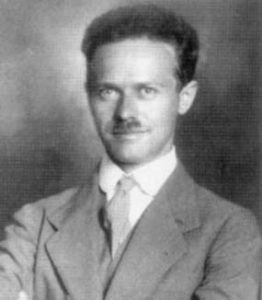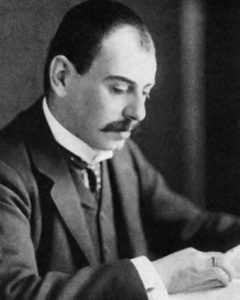(published in El Cultural, supplement of El Mundo on the occasion of Pi Day)
In my first year as a mathematics student, one of the teachers defined the number \(\pi\) in a rather fanciful way. The professor, addicted to the logical deductive method, had axiomatically introduced us to the trigonometric functions \(\mathrm{sen}\,x\) and \(\cos x\), and then defined the number \(\pi\) as the double of the infimum of the positive numbers \(a\) that verify \(\mathrm {sen}\,a=1\). It always seemed to me a rather odd definition, far removed from the elegant and luminous one found by the Greeks: \(\pi\) is the ratio – the quotient, we say today – between the area of any circle and that of the square raised above its radius or, as Archimedes showed, the ratio between the length of any circle and its diameter. What our professor never told us is that, behind the definition he used, there was a sinister story of hatred, evil and crime, one of the most terrible in history: that of the genocide perpetrated by the Nazis against the Jews.

As the 1930s unfolded, Nazi ideology was carried to its ultimate consequences in Germany, and eventually tainted mathematics as well. The main ideologue of mathematical Nazism was Ludwig Bieberbach (1886-1982). According to his bizarre mathematical/racial doctrine, there was a “degenerate”, “inorganic”, “alien to reality”, “enemy of life” mathematics; it was the mathematics made by Jews – also by Frenchmen – and contaminated by their racial idiosyncrasy: “Jewish thought always begins with something that is already mental and never with something natural or coming from human experience”, he went so far as to say. As if mental experience were not human!

Bieberbach liked to quote two phrases by the mathematicians Carl Gustav Jacobi (1804-1851), a Jew, and Georg Cantor (1841-1918) – whose mathematics the Nazis branded as Jewish: “In honour of the human spirit”, Jacobi once wrote in answer to the question: “Why do we have to do mathematics? Cantor’s sentence: “The essence of mathematics is freedom” – no doubt a sentence that does not sit well with the Nazi ideology. According to Bieberbach, these sentences were the proof that came to demonstrate the “mental” contamination that afflicted the non-Aryan mathematics that both Jacobi and Cantor did.
In the face of Jewish mathematics, Aryan mathematics, “organic”, “concrete”, “completely open to Reality”, “traversed by the stream of experience”, was raised up against Jewish mathematics.
Thus, some mathematical concepts ended up being cited as “spirit of our spirit and blood of our blood, pieces of the Nordic soul”, while science was a product dependent on “the ideology, race and blood of its creators”. According to Bieberbach, although a mathematical result is a mathematical result, although the value of \(\pi\) is the value of \(\pi\), and the Pythagorean theorem the Pythagorean theorem, nationality, race and blood do affect certain approaches, styles, pedagogical attitudes and beliefs about the nature of mathematics and, by affecting all this, end up also affecting the kind of mathematics one or the other produces. As a consequence, Bieberbach concluded that the existence of non-Aryan mathematicians in Germany could end up corrupting Aryan mathematicians, which not only justified but demanded the need for “purification”. Even more so than the racial laws that Hitler introduced as soon as he came to power in 1933.
All these arguments are nonsense and go against history, because within the German mathematical tradition, Jews have been fundamental elements; this also extends to the artistic, intellectual and cultural tradition in general. Its most famous scientist was Albert Einstein, a Jew; and 14 of the 38 German Nobel Prize winners between 1905 and 1936 were Jews. In the 19th century, the aforementioned mathematicians Jacobi, a Jew, and Cantor – who was not Jewish despite the Nazis’ insistence that he had to be, given the type of mathematics he did – were outstanding, second only to Gauss and, of course, on an equal footing with Karl Weierstrass (1815-1897), who was not Jewish, but many of his disciples were Jewish. And in the first decades of the 20th century there were many mathematicians who were Jewish, German and excellent: Otto Blumenthal (1876-1944), Richard Courant (1888-1972), Felix Hausdorff (1868-1942), Adolf Hurwitz (1859-1919), Edmund Landau (1877-1938), Hermann Minkowski (1864-1909), and Emmy Noether (1882-1935). It would be a denial of reality not to recognise that the tangle of relationships established between these mathematicians and those considered Aryans was extraordinarily dense – with a notorious promiscuity of ethnicities, for example, between thesis supervisors and doctoral students; It would be the most absurd fabulation not to agree that, regardless of the colour of their skin, the collaboration between them was very close – Bieberbach himself collaborated with Jewish mathematicians – and it would be pure falsehood not to admit that the influence they exerted on each other was equally intense – regardless of the colour of their eyes or hair. Whoever pretends that, over and above this intense maceration in a common mathematical brew, the shades of skin necessarily impose a different personality on the mathematics that each produced, is only showing some kind of impairment, corruption or severe disorder of intellectual capacity.
Many of the mathematicians mentioned above suffered, first the Nazi exclusion laws, then total persecution; some were able to flee Germany – such as Einstein, Courant or Noether –, others paid with their lives – such as Hausdofff or Blumenthal.

Edmund Landau was a celebrity who had made Göttingen a haven for number theorists. Despite Landau’s Jewish condition, he was initially exempted from the racial laws, but eventually had to resign, cornered by students. The story has a point of surrealism that would be comical were it not for the fact that the mere reference to the comical in those circumstances is in itself disrespectful. For the reason the students gave for dismissing Landau was his way of defining the number \(\pi\), which happened to be the one I referred to above and which was used, almost seven decades later, by one of the professors in my first year at university. Landau never taught in Göttingen again, though he did teach elsewhere in Europe. Hardy, for example, managed to get him to teach for a short time in England: “It was touching to see Landau’s delight when he found himself again at the blackboard and his grief when he saw it end,” Hardy later wrote.
Landau’s students protested not because his pedagogical definition of \(\pi\) was somewhat questionable, but because they considered his way of defining the number \(\pi\) to be too unpatriotic, too un-German. Bieberbach wrote about the matter, justifying the attitude of the students: “A few months ago Mr Landau was forced to give up his teaching activities because of differences with the students […] This is an example that racial differences between a teacher and his students should not be allowed […] The instinct of the students in Göttingen made them see that Landau’s way of teaching was not truly German”. Some of Bieberbach’s manuscripts have also survived, describing the attitude of the students as “intelligent”, “justified”, “worthy of thanks” and “manly”. Bieberbach’s message is clear: “cleansing” was to be carried out not only by using ethnic cleansing laws, but also by using social pressure and cornering.
Today, when patriotic and exclusionary slogans resound almost everywhere with renewed fanfare, it is worth remembering the nationalist metastasis that Nazism wrought in German society (and which reached into something supposedly as little given to ideology as mathematics); it provoked the most terrible war humanity has ever known and one of its most dreadful genocides.
Bibliography
A.J. Durán, Pasiones, piojos, dioses y … matemáticas, Destino, Barcelona, 2009.
H. Mehrtens, Ludwig Bieberbach and “Deustche Mathematik”, en Studies in the history of Mathematics, E. R. Phillips (editora), The Mathematical Association of America, 1987.
S.L. Segal, Mathematicians under the nazis, Princeton University Press, Princeton, 2003.

Leave a Reply